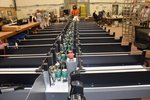


Thurston County auditor’s office, which runs county elections, puts every ballot through a step-by-step process to ensure election security and accuracy in counting Yelm’s primary election ballots.
Thurston County Auditor Mary Hall took the Nisqually Valley News on a tour of the Ballot Processing Center (BPC) while votes were being counted to demonstrate the path a ballot takes in the elections process and show transparency and security in county elections.
For transparency’s sake, all ballot processes are recorded and live streamed.
Hall said the best practice for election security is ensuring there are at least two people working on every step of the process. That way, there isn’t one person who can alter ballots without oversight.
The other aspect of election security that is most beneficial to voters is the technology used for counting, Hall said.
“Our technology is really tight,” Hall said. “We’re not connected to the internet in (the BPC). So the tabulators are not connected to the internet in any way. They are networked to each other, but not to the internet.”
She said this aspect is important, due to the misinformation being spread about BPC hacking across the nation.
“There are too many accusations that people hack our systems,” Hall said. “I think we can lock it down tight enough and whitelist machines so only those machines can get in. There are alot of precautions you can take, but I think it’s public perception of why it’s important.”
She said this perception problem is nationwide.
“Them saying votes change is not true,” Hall said, adding that there are some network computers that the BPC uses to upload results to the state.
The ballot starts at the sorter, which checks the ballots in along a belt system that was originally designed as a mail sorter.
“It’s got a camera that takes a picture of the signature on the ballot envelope, reads the barcode, which contains the voter I.D. number and precinct,” Hall said.
Next, the ballot goes over to signature verification. Election workers check for differences between the signature on the ballot and the one on the voter registration.
“It’s a pretty fast process, and what most people don’t realize is we verify the signature on every ballot envelope,” Hall said. “The ones that don’t match really jump off the screen at you.”
To have their ballot counted, voters must have a matching signature and a signed affidavit.
For ballots that fail the signature rate, the election workers contact the voter and “cure” the ballot by getting the updated information, such as a signature or signed affidavit.
Thurston County has the highest cure rate in the state, Hall said.
After the signature check, they go back on the sorter, and it kicks all the ballots out that have been given a challenge code, some sort of irregularity or discrepancy with the ballot. Then it sorts the ballots down to precinct level.
“The first pass (through the sorter) is taking a picture and checking the signature,” Hall said. “The second pass is making sure what’s valid and rejecting what’s been challenged.”
The next stop is the ballot inspection process, which checks for stray marks or for damage to the ballot.
“We are required by state law to manually check each ballot,” Hall said. “What they’re looking for is stray marks, corrections — you know, somebody votes for a candidate and changes their mind and puts a line through it and marks their next choice.”
But such ballots, and those that are damaged, will not be counted correctly on the tabulator, or counting machine. So election workers duplicate the ballot and remove the vote that has been crossed out.
Once all the ballots are ready to be counted, they go to the tabulators, which in addition to counting the ballots, they kick out ballots with overvotes, which are then resolved electronically, wherever possible. This happens when the ballot is physically good, but has a discrepancy that does not require a duplicate ballot.
Once resolved, the corrected ballots are counted.
“We never not count ballots because there is an error or a problem with the ballot,” Hall said. “The only people that can reject ballots are the canvassing board.”
The canvassing board is made up of the auditor, prosecuting attorney and chair of the county commission.
They approve or reject ballots on a case by case basis, individually.
The ballots are then stored by precinct, to be held for possible recounts.
Trays that have been emptied of ballots, meaning they have been counted, are turned upside down, so that no ballot can be missed, Hall said.
Ballots are archived for the duration required by the state for each type of election.